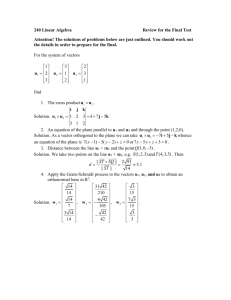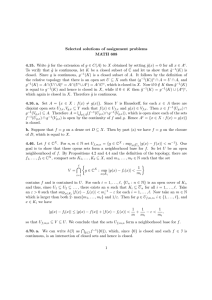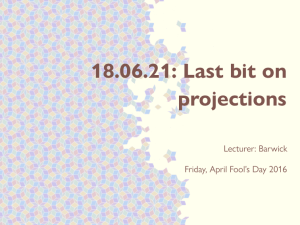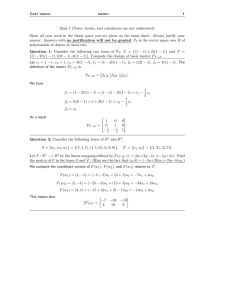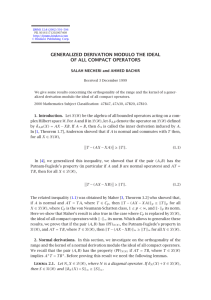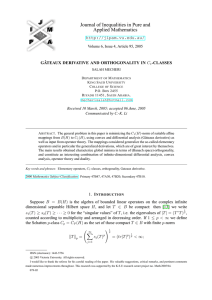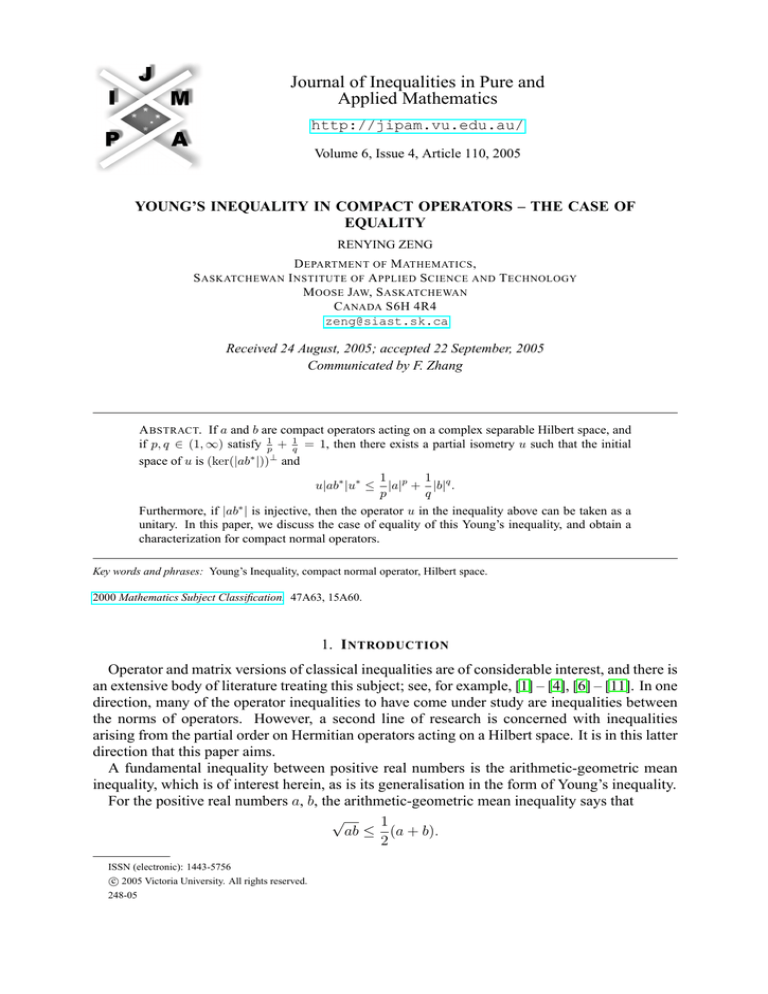
Journal of Inequalities in Pure and
Applied Mathematics
http://jipam.vu.edu.au/
Volume 6, Issue 4, Article 110, 2005
YOUNG’S INEQUALITY IN COMPACT OPERATORS – THE CASE OF
EQUALITY
RENYING ZENG
D EPARTMENT OF M ATHEMATICS ,
S ASKATCHEWAN I NSTITUTE OF A PPLIED S CIENCE AND T ECHNOLOGY
M OOSE JAW, S ASKATCHEWAN
C ANADA S6H 4R4
zeng@siast.sk.ca
Received 24 August, 2005; accepted 22 September, 2005
Communicated by F. Zhang
A BSTRACT. If a and b are compact operators acting on a complex separable Hilbert space, and
if p, q ∈ (1, ∞) satisfy p1 + 1q = 1, then there exists a partial isometry u such that the initial
space of u is (ker(|ab∗ |))⊥ and
1
1
u|ab∗ |u∗ ≤ |a|p + |b|q .
p
q
Furthermore, if |ab∗ | is injective, then the operator u in the inequality above can be taken as a
unitary. In this paper, we discuss the case of equality of this Young’s inequality, and obtain a
characterization for compact normal operators.
Key words and phrases: Young’s Inequality, compact normal operator, Hilbert space.
2000 Mathematics Subject Classification. 47A63, 15A60.
1. I NTRODUCTION
Operator and matrix versions of classical inequalities are of considerable interest, and there is
an extensive body of literature treating this subject; see, for example, [1] – [4], [6] – [11]. In one
direction, many of the operator inequalities to have come under study are inequalities between
the norms of operators. However, a second line of research is concerned with inequalities
arising from the partial order on Hermitian operators acting on a Hilbert space. It is in this latter
direction that this paper aims.
A fundamental inequality between positive real numbers is the arithmetic-geometric mean
inequality, which is of interest herein, as is its generalisation in the form of Young’s inequality.
For the positive real numbers a, b, the arithmetic-geometric mean inequality says that
√
1
ab ≤ (a + b).
2
ISSN (electronic): 1443-5756
c 2005 Victoria University. All rights reserved.
248-05
2
R ENYING Z ENG
Replacing a, b by their squares, this could be written in the form
1
ab ≤ (a2 + b2 ).
2
R. Bhatia and F. Kittaneh [3] extended the arithmetic-geometric mean inequality to positive
(semi-definite) matrices a, b in the following manner: for any n × n positive matrices a, b, there
is an n × n unitary matrix u such that
1
u|ab∗ |u∗ ≤ (a2 + b2 ).
2
(The modulus |y| is defined by
1
|y| = (y ∗ y) 2 .
for any n × n complex matrix y.) We note that the product ab of two positive matrices a and b
is not necessarily positive.
Young’s inequality is a generalisation of the arithmetic-geometric mean inequality: for any
positive real numbers a, b, and any p, q ∈ (1, ∞) with p1 + 1q = 1,
1
1
ab ≤ ap + bq .
p
q
T. Ando [2] showed Young’s inequality admits a matrix-valued version analogous to the Bhatia–
Kittaneh theorem: if p, q ∈ (1, ∞) satisfy p1 + 1q = 1, then for any pair a, b of n × n complex
matrices, there is a unitary matrix u such that
1
1
u|ab∗ |u∗ ≤ |a|p + |b|q .
p
q
Although finite-rank operators are norm-dense in the set of all compact operators acting on a
fixed Hilbert space, the Ando–Bhatia–Kittaneh inequalities, like most matrix inequalities, do
not immediately carry over to compact operators via the usual approximation methods, and
consequently only a few of the fundamental matrix inequalities are known to hold in compact
operators.
J. Erlijman, D. R. Farenick, and the author [4] developed a technique through which the
Ando–Bhatia–Kittaneh results extend to compact operators, and established the following version of Young’s inequality.
Theorem 1.1. If a and b are compact operators acting on a complex separable Hilbert space,
and if p, q ∈ (1, ∞) satisfy p1 + 1q = 1, then there is a partial isometry u such that the initial
space of u is (ker(|ab ∗ |))⊥ and
1
1
u|ab∗ |u∗ ≤ |a|p + |b|q .
p
q
Furthermore, if |ab∗ | is injective, then the operator u in the inequality above can be taken to be
a unitary.
Theorem 1.1 is made in a special case as a corollary below.
Corollary 1.2. If a and b are positive compact operators with trivial kernels, and if t ∈ [0, 1],
then there is a unitary u such that
u|at b1−t |u∗ ≤ ta + (1 − t)b.
The proof of the following Theorem 1.3 is very straightforward.
J. Inequal. Pure and Appl. Math., 6(4) Art. 110, 2005
http://jipam.vu.edu.au/
YOUNG ’ S I NEQUALITY I N C OMPACT O PERATORS – T HE C ASE O F E QUALITY
3
Theorem 1.3. If A is a commutative C ∗ -algebra with multiplicative identity, and if p, q ∈
(1, ∞) satisfy p1 + 1q = 1, then
1
1
|ab∗ | ≤ |a|p + |b|q
p
q
for all a, b ∈ A. Furthermore, if the equality holds, then
|b| = |a|p−1 .
2. A N E XAMPLE
We give an example here for convenience.
We illustrate that, in general, we do not have
1
1
|ab∗ | ≤ |a|p + |b|q .
p
q
But, for this example, there exists a unitary u such that
1
u|ab∗ |u∗ ≤ (|a|p + |b|q ).
2
1 1
2 0
and b =
, then a and b are (semi-definite) positive
Example 2.1. If a =
0 1
1 1
and
1 2
3 1
2
(a + b ) =
,
1 12
2
and
√
√
!
10
2
√
10
2
|ab∗ | = |ab| =
However,
10
2
√
10
2
.
√
1
c = (a2 + b2 ) − |ab| =
2
3−
1−
10
2
√
10
2
2
√
1−
3−
10
2
√
10
2
!
is not a (semi-definite) positive matrix, i.e., c = 12 (a2 + b ) − |ab| ≥ 0 does not hold. (In fact,
the determinant of c satisfies that det(c) < 0). So, we do not have
1
|ab| ≤ (a2 + b2 ).
2
But the spectrum of |ab| is
σ(|ab|) =
n√
o
10, 0 ,
the spectrum of 12 (a2 + b2 ) is
σ
1 2
7
2
(a + b ) =
,1 .
2
2
Therefore, there exists a unitary matrix u such that
1
u|ab|u∗ ≤ (a2 + b2 ).
2
We compute the unitary matrix u as follows.
J. Inequal. Pure and Appl. Math., 6(4) Art. 110, 2005
http://jipam.vu.edu.au/
4
R ENYING Z ENG
Taking unitary matrices
1
v=√
5
−2 1
−1 −2
1 1
1 −1
and
1
w=√
2
,
we then have
v
1 2
2
(a + b ) v ∗ =
2
and
∗
√
∗
w|ab|w ≤ v
0
!
,
0 1
10 0
0 0
w|ab|w =
Therefore
7
2
.
1 2
2
(a + b ) v ∗ .
2
By taking a unitary matrix
1
u=v w= √
10
∗
−3 −1
−1 3
,
we get
1
u|ab|u∗ ≤ (a2 + b2 ).
2
3. T HE C ASE O F E QUALITY I N C OMMUTING N ORMAL O PERATORS
In this section, we discuss the cases of equality in Young’s inequality.
Assume that H denotes a complex, separable Hilbert space of finite or infinite dimension.
The inner product of vectors ξ, η ∈ H is denoted by hξ, ηi, and the norm of ξ ∈ H is denoted
by ||ξ||.
If x : H → H is a linear transformation, then x is called an operator (on H) if x is also
continuous with respect to the norm-topology on H. The complex algebra of all operators on
H is denoted by B(H), which is a C ∗ -algebra. We use x∗ to denote the adjoint of x ∈ B(H).
An operator x on H is said to be Hermitian if x∗ = x. A Hermitian operator x is positive
+
if σ(x) ⊆ R+
0 , where σ(x) is the spectrum of x, and R0 is the set of non-negative numbers.
Equivalently, x ∈ B(H) is positive if and only if hxξ, ξi ≥ 0 for all ξ ∈ H. If a, b ∈ B(H) are
Hermitian, then a ≤ b shall henceforth denote that b − a is positive.
Lemma 3.1. If a, b ∈ B(H) are normal and commuting, where B(H) is the complex algebra
of all continuous linear operators on H, then
|a||b| = |b||a|,
and |a||b| is positive.
Proof. We obviously have
a∗ b ∗ = b ∗ a∗ .
And by the Fuglede theorem [5] we get
a∗ b = ba∗ ,
ab∗ = b∗ a.
On the other hand, if c, d ∈ B(H) with c,d positive and commuting, then
c1/2 d1/2 · c1/2 d1/2 = c1/2 c1/2 · d1/2 d1/2 = cd.
J. Inequal. Pure and Appl. Math., 6(4) Art. 110, 2005
http://jipam.vu.edu.au/
YOUNG ’ S I NEQUALITY I N C OMPACT O PERATORS – T HE C ASE O F E QUALITY
5
Hence
(cd)1/2 = c1/2 d1/2 .
Therefore
|a||b| = (a∗ a)1/2 (b∗ b)1/2
= (a∗ ab∗ b)1/2
= (b∗ b)1/2 (a∗ a)1/2
= |b||a|.
Which implies that |a||b| is positive and
|a||b| = (|a||b|)∗ = |b||a|.
(In fact, |a||b| is the positive square root of the positive operator a∗ ab∗ b).
Lemma 3.2. If a, b ∈ B(H)are normal operators such that ab = ba, then the following statements are equivalent:
(i) the kernel of |ab∗ | : ker(|ab∗ |) = {0};
(ii) a and b are injective and have dense range.
Proof. (i) → (ii). Let b = w|b| be the polar decomposition of b. By observation we have
||a||b|| = (|b||a|2 |b|)1/2 .
Thus, because the closures of the ranges of a positive operator and its square root are equal, the
closures of the ranges of |b||a|2 |b|and ||a||b|| are the same. Moreover, as w∗ w||a||b|| = ||a||b||,
we have that
(3.1)
f (w|b||a|2 |b|w∗ ) = wf (|b||a|2 |b|)w∗ ,
for all polynomials f . Choose δ > 0 so that σ(|b||a|2 |b|) ⊆ [0, δ]. By the Weierstrass
ap√
proximation theorem, there is a sequence of polynomials fn such that fn (t) → t(n → ∞)
uniformly on [0, δ]. Thus, from (3.1) and functional calculus,
(w|b||a|2 |b|w∗ )1/2 = w(|b||a|2 |b|)1/2 w∗ = w||a||b||w∗ .
Let a = v|a| be the polar decomposition of a. Then the left-hand term in the equalities above
expands as follows:
(w|b||a|2 |b|w∗ )1/2 = w(|b||a|v ∗ v|a||b|)1/2 w∗ = (ba∗ ab∗ )1/2 = |ab∗ |.
Thus,
|ab∗ | = w||a||b||w∗ .
Because a and b are commuting normal, from Lemma 3.1 |a||b| = |b||a| and |a||b| is positive.
This implies that
|ab∗ | = w|a||b|w∗ .
If ξ ∈ ker(w∗ ), then ξ ∈ ker(|ab∗ |). Hence ker(w∗ ) = {0}, which means that the range of
ran(w) = H. Hence, w is unitary. By the theorem on polar decomposition [5, p. 75], b is
injective and has dense range.
Let a = v|a| be the polar decomposition of a. We know that ab = ba implies that ab∗ = b∗ a
(again, by Fuglede theorem). Therefore, we can interchange the role of a and b in the previous
paragraph to obtain: a∗ is injective and has dense range. Thus, a is injective and has dense
range.
J. Inequal. Pure and Appl. Math., 6(4) Art. 110, 2005
http://jipam.vu.edu.au/
6
R ENYING Z ENG
(ii) → (i). From the hypothesis we have polar decompositions a = v|a|, b = w|b|, where v and
w are unitary [5, p. 75]. Therefore, ker(|a|) = ker(|b|) = {0}. Because
|ab∗ | = w|a||b|w∗
and w is unitary, we have
ker(ab∗ ) = {0}.
Lemma 3.3. If x ∈ B(H) is positive, compact, and injective, and if x ≤ u∗ xu for some unitary
u, then u is diagonalisable and commutes with x.
Proof. Because x is injective, the Hilbert space H is the direct sum of the eigenspaces of x:
X⊕
H=
ker(x − λ1).
λ∈σp (x)
Let
σp (x) = {λ1 , λ2 , ...},
where λ1 > λ2 > · · · > 0 are the (distinct) eigenvalues of x, listed in descending order. Our
first goal is to prove that ker(x − λj 1) is invariant under u and u∗ for every positive integer j;
we shall do so by induction.
Start with λ1 ; note that λ1 = ||x||.
If ξ ∈ ker(x − λ1 1) is a unit vector, then
λ1 = λ1 hξ, ξi
= hλ1 ξ, ξi
= hxξ, ξi
≤ hu∗ xuξ, ξi
= hxuξ, uξi
≤ ||x|| · ||uξ||2 = λ1 .
Thus,
hxuξ, uξi = λ1 = max{hxη, ηi : ||η|| = 1}.
Which means that uξ is an eigenvector of x corresponding to the eigenvalue λ1 . Then,
uξ ∈ ker(x − λ1 1).
Because ker(x − λ1 1) is finite-dimensional and u is unitary, we have that
u : ker(x − λ1 1) → ker(x − λ1 1)
is an isomorphism. Furthermore, U |ker(x−λ1 1) is diagonalisable because
dim(ker(x − λ1 1)) < ∞,
where U |ker(x−λ1 1) is the restriction of U in the subspace ker(x − λ1 1). Hence, ker(x − λ1 1) is
invariant under u∗ (because ker(x − λ1 1) has a finite orthonormal basis of eigenvectors of u),
which means that if
η ∈ ker(x − λ1 1),
then
uη ∈ ker(x − λ1 1).
Now choose λ2 , and pick up a unit vector ξ ∈ ker(x − λ2 1).
Note that
λ2 = max{hxη, ηi : ||η|| = 1, η ∈ ker(x − λ1 1)⊥ }.
J. Inequal. Pure and Appl. Math., 6(4) Art. 110, 2005
http://jipam.vu.edu.au/
YOUNG ’ S I NEQUALITY I N C OMPACT O PERATORS – T HE C ASE O F E QUALITY
7
Using the arguments of the previous paragraph,
λ2 ≤ hxξ, ξi ≤ hxuξ, uξi ≤ λ2 .
(Because uξ is a unit vector orthogonal to ker(x − λ1 1)). Hence, by the minimum maximum
principle,
uξ ∈ ker(x − λ2 1).
So
u : ker(x − λ2 1) → ker(x − λ2 1)
is an isomorphism, ker(x − λ2 1) has an orthonormal basis of eigenvectors of u.
And if η ∈ ker(x − λ1 1) ⊕ ker(x − λ2 1), then
uη ∈ ker(x − λ1 1) ⊕ ker(x − λ2 1).
Inductively, assume that u leaves ker(x − λj 1) invariant for all 1 ≤ j ≤ k, and look at λk+1 . By
the arguments above,
⊥
X ⊕
ker(x − λj 1)
1≤j≤k
is also invariant under u. Hence, if ξ ∈ ker(x − λk+1 1) is a unit vector, then
λk+1 = hxξ, ξi
≤ hxuξ, uξi
X ⊕
≤ max hxη, ηi : ||η|| = 1, η ∈
1≤j≤k
⊥ ker(x − λj 1)
= λk+1 .
By the minimum-maximum principle, uξ is an eigenvector of x corresponding to λk+1 . Hence,
ker(x − λk+1 1)
is invariant under u and u∗ . This completes the induction process.
What these arguments show is that H has an orthonormal basis {φ}∞
j=1 of eigenvectors of
both x and u; hence
xuφj = uxφj ,
for each positive integer j. Consequently,
xuξ = uxξ, ∀ξ ∈ H.
meaning that
xu = ux.
Below is a major result of this paper
Theorem 3.4. Assume that a, b ∈ B(H) are commuting compact normal operators, each being
injective and having dense ranges. If there exists a unitary u such that:
1
1
u|ab∗ |u∗ = |a|p + |b|q ,
p
q
for some p, q ∈ (1, ∞) with
1
p
+
1
q
= 1, then
|b| = |a|p−1 .
J. Inequal. Pure and Appl. Math., 6(4) Art. 110, 2005
http://jipam.vu.edu.au/
8
R ENYING Z ENG
Proof. By the hypothesis, if b = w|b| is the polar decomposition of b, then ker(|ab∗ |) = {0},
(Lemma 3.2) and w is unitary ([5, p. 75]). Moreover,
|ab∗ | = w|a||b|w∗ ,
as a and b are commuting normals (noting that |a||b| is positive from Lemma 3.1). Thus
u|ab∗ |u∗ = p1 |a|p + 1q |b|q becomes
1
1
uw|a||b|w∗ u∗ = |a|p + |b|q .
p
q
(3.2)
By Theorem 1.3, and because |a||b| = |b||a| (Lemma 3.2), we get
1 p 1 q
|a| + |b| ≥ |a||b|.
p
q
Hence from (3.2)
(3.3)
1
1
uw|a||b|w∗ u∗ = |a|p + |b|q ≥ |a||b|.
p
q
Because uw is unitary (since w is unitary from the proof of Lemma 3.2), and because |a||b| is
positive, Lemma 3.3 yields
|a||b| = uw|a||b|w∗ u∗ .
Hence, (3.2) becomes
1
1
|a||b| = |a|p + |b|q .
p
q
(3.4)
Let
λ1 (|a|) ≥ λ2 (|a|) ≥ · · · > 0
and
λ1 (|b|) ≥ λ2 (|b|) ≥ · · · > 0
be the eigenvalues of |a| and |b|. Because |a| and |b| belong to a commutative C ∗ -algebra, the
spectra of |a||b| and p1 |a|p + 1q |b|q are determined from the spectra of |a| and |b|, i.e., for each
positive integer k,
λk (|a||b|) = λk (|a|)λk (|b|),
and
1 p 1 q
1
1
λk
|a| + |b| = λk (|a|)p + λk (|b|)q .
p
q
p
q
Therefore, the equation (3.4) implies that for every k
1
1
λk (|a|)λk (|b|) = λk (|a|)p + λk (|b|)q .
p
q
This is equality in the (scalar) Young’s inequality, and hence for every k
λk (|b|) = λk (|a|)p−1
which yields (note that a and b are normal operators)
|b| = |a|p−1 .
From Theorem 3.4 we immediately have
J. Inequal. Pure and Appl. Math., 6(4) Art. 110, 2005
http://jipam.vu.edu.au/
YOUNG ’ S I NEQUALITY I N C OMPACT O PERATORS – T HE C ASE O F E QUALITY
9
Corollary 3.5. If a and b are positive commuting compact operators such that |ab| is injective,
and if there is an isometry v ∈ B(H) for which
u|at b1−t |u∗ = ta + (1 − t)b
for some t ∈ [0, 1], then
b = at−1 .
Theorem 3.6. Assume that a, b ∈ B(H) are commuting compact normal operators, each being
injective and having dense range. If
|b| = |a|p−1 ,
then there exists a unitary u such that:
1
1
u|ab∗ |u∗ = |a|p + |b|q ,
p
q
for p, q ∈ (1, ∞) with
1
p
+
1
q
= 1.
Proof. By the hypothesis, it is easy to get
1
1
|a||b| = |a|p + |b|q ,
p
q
we note that |a||b| is positive here.
If b = w|b| is the polar decomposition of b, then ker(|ab∗ |) = {0} (Lemma 3.2), w is unitary
([5, p. 75]), and
|ab∗ | = w|a||b|w∗ .
Let u = w∗ . Then
1
1
u|ab∗ |u∗ = |a|p + |b|q .
p
q
Corollary 3.7. If a and b are positive commuting compact operators such that ab is injective,
and if there exists t ∈ [0, 1] such that
b = at−1 ,
then there is an isometry v ∈ B(H) for which
u|at b1−t |u∗ = ta + (1 − t)b.
R EFERENCES
[1] C.A. AKEMANN, J. ANDERSON, AND G.K. PEDERSEN, Triangle inequalities in operator algebras, Linear and Multilinear Algebra, 11 (1982), 167–178.
[2] T. ANDO, Matrix Young’s inequalities, Oper. Theory Adv. Appl., 75 (1995), 33–38.
[3] R. BHATIA AND F. KITTANEH, On the singular values of a product of operators, SIAM J. Matrix
Anal. Appl., 11 (1990), 272–277.
[4] J. ERLIJMAN, D.R. FARENICK, AND R. ZENG, Young’s inequality in compact operators, Oper.
Theory. Adv. and Appl., 130 (2001), 171–184.
[5] P.R. HALMOS, A Hilbert Space Problem Book, 2nd Edition, Springer-Verlag, New York, 1976.
[6] F. HANSEN AND G.K. PEDERSEN, Jensen’s inequality for operators and Lowner’s theorem,
Math. Ann., 258 (1982), 29–241.
[7] F. HIAI AND H. KOSAKI, Mean for matrices and comparison of their norms, Indiana Univ. Math.
J., 48 (1999), 900–935.
J. Inequal. Pure and Appl. Math., 6(4) Art. 110, 2005
http://jipam.vu.edu.au/
10
R ENYING Z ENG
[8] O. HIRZALLAH AND F. KITTANEH, Matrix Young inequality for the Hilbert-Schmidt norm,
Linear Algebra Appl., 308 (2000), 77–84.
[9] R.C. THOMPSON, The case of equality in the matrix-valued triangle inequality, Pacific J. Math.,
82 (1979), 279–280.
[10] R.C. THOMPSON, Matrix type metric inequalities, Linear and Multilinear Algebra, 5 (1978),
303–319.
[11] R.C. THOMPSON, Convex and concave functions of singular values of matrix sums, Pacific J.
Math., 66 (1976), 285–290.
[12] R. ZENG, The quaternion matrix-valued Young’s inequality, J. Inequal. Pure and Appl. Math., 6(3)
(2005), Art. 89. [ONLINE: http://jipam.vu.edu.au/article.php?sid=562]
J. Inequal. Pure and Appl. Math., 6(4) Art. 110, 2005
http://jipam.vu.edu.au/


